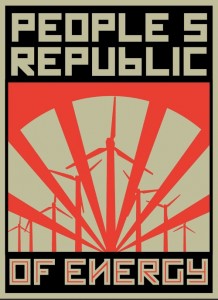We all know of the great need to wean ourselves of fossil fuel energy and ‘transition’ to cleaner energy with more sustainable resources, such as wind and wave energy. There are, however, many different opinions on how best to do this. In recent times we have had some ferocious debates in Ireland about our energy policy with wind turbines, peat burning, and fracking all being hot topics.
Earlier this year, plans to erect 1,000 wind turbines across the midlands, for export of energy to Britain, were scrapped. This plan was clouded in controversy. The main concerns were health and noise impacts, as well as the size of the turbines themselves. It had been claimed that the community had not been properly informed of the plans for this large development.
No wonder, then, that wind energy has developed a negative reputation in recent years, largely due to large scale developments and the above mentioned concerns of nearby residents and landowners. It is usually the case that these developments are projects of large energy firms, who often have no connection to the community (or even the country) in which they are to be developed. This often leads to resentment between locals and officials, with locals viewing the companies as benefitting at the expense of the local community and environment.
What if local communities could instigate, plan and reap the rewards of renewable energy projects in their own areas? This is possible, with energy co–ops. Friends of the Earth Europe is behind a new campaign called Community Power, which supports people’s ownership of community energy projects. The idea is that communities would form energy co–operatives which would initiate small-scale local renewable energy developments. Communities would be involved in the planning from the beginning, and would also be in control of the size and location of wind turbines. As well as the democratic benefits of such schemes, there is the possibility for communities to gain a stream of income or investment for community projects from the sale of electricity into the grid.
Carbon Co-op
Relatively nearby the site of the scrapped midlands project is Tipperary’s Templederry, which has Ireland’s first community owned windpower scheme. The Templederry project grew out of a rural development plan for the area, written by Dr Tom Collins of NUI Maynooth in 1999, which placed a large emphasis on renewable energy. Following this a group was formed, and feasibility studies were conducted into various renewable energy projects. After it was decided to press ahead with a wind farm, attention turned to funding. Further to the investment of the local shareholders, funding was received from the local LEADER and Enterprise Board. A partnership was reached between energy firm Enercon and De–Lag Landen, to ensure the rest of the project was funded. The group is of the view that it is much more palatable to engage with an energy firm once the idea and project has been initiated locally.
After over ten years of planning, the village now has two wind turbines owned by 32 community stakeholders. The scheme is producing 15GWh of energy per annum and selling it to the grid. It receives payments on a two monthly basis for the energy it sells. Each stakeholder is an equal shareholder, and invested an initial €1000 each, with further funding coming from leader grant aid, a loan and project finance from a bank.
Elsewhere in Ireland, Energy co – operatives Ireland (www.energyco-ops.ie) is a co-operative consultancy promoting community access to renewable energy. They are working with East Clare Renewable Energy Ltd, a Co – Op that hopes to build the largest community owned windfarm in Ireland, which will create up to 200 jobs and provide enough energy for all of Co. Clare.
While Ireland is a novice in this area, Germany, a leader in the field, has developed 34% of its renewable energy output from community owned projects.
While there are important benefits and advantages from community owned energy there are still a number of hurdles that make it difficult for communities to take ownership of their resources and create sustainable employment and investment. Not least among these are access to start up capital and the lengthy and costly planning application process for these types of projects.
At a time when climate change, our energy bills and future energy supply are becoming more important issues, it makes sense to consider new and non-conventional avenues to ensure security into the future. It remains to be seen what will come of the government’s recent Green Paper on Energy in Ireland, however, it is hoped that with strong input from groups such as Transition Towns and Friends of the Earth it will have real sustainability at its centre. Regardless of this, communities can get ahead of the game, secure their energy supply and perhaps even gain a financial windfall for other vital projects from the proceeds of community energy.
Sources
Community Power: for people’s ownership of renewable energy www.communitypower.eu/en/ See the Notice for Workshop on 20 November 2014, Dublin, Ireland, on: Community-energy: empowering local authorities and their communities to guide local sustainable energy roll-out
Catherine Wall, “Templederry Community Wind farm – Case Study.” Tipperary Energy Agency tea.ie/projects/templederry-commmunity-wind-farm-case-study/
Editor’s Note: See the Analysis of Ireland’s Green Paper on Energy Policy in the Reports section of this (Sept 2014) issue of irish environment
Mícheál Callaghan is a law graduate with a strong interest in sustainability. Co – founder of Transition Monaghan, Mícheál has enrolled for the LLM in Environmental Law and Sustainable Development at Queens University Belfast.



No comments yet, add your own below